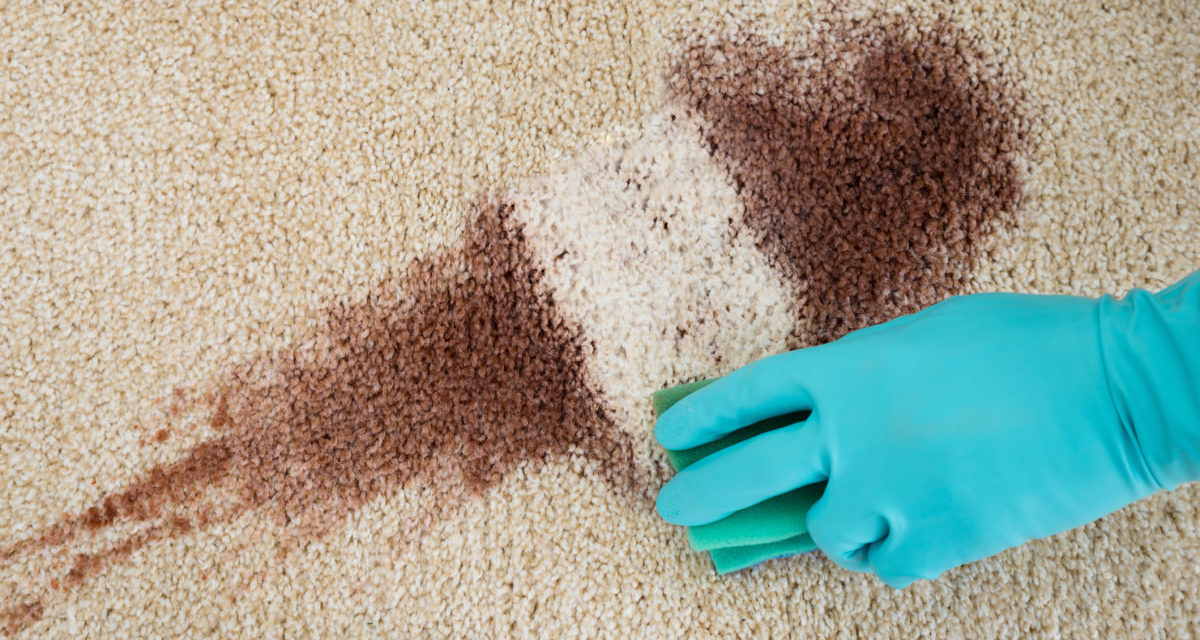DIY Carpet Cleaning Solutions
Being a resident of New Orleans has its perks. We have the best food and the greatest drinking culture. We also have the best parties outside and inside the home. The downside of those indoor parties is the big mess left afterward that might need extensive cleaning. Usually, the amount of effort going into preparing for the party can leave the after party cleaning supplies off our list of to-dos. We’ve compiled a list of DIY carpet cleaning solutions and some helpful tips on which cleaning solution to use for specific stains.Detergent solution
– Mix 1 teaspoon of mild clear or white neutral detergent (a mild dishwashing liquid containing no alkalis or bleach) in 1 cup of warm water. Do not use laundry detergent, which contains optical brighteners that may discolor the fibers.Ammonia solution
– Mix 1 tablespoon of household ammonia with ½ cup of water. Apply in a well-ventilated area. NEVER mix with bleach.Vinegar solution
– Mix 1/3 cup of white household vinegar and 2/3 cup of water.Enzyme Detergent solution
– Mix a solution of enzyme laundry detergent by following the directions on the package. Allow the solution to remain on the stain for the length of time recommended by the manufacturer. Do not use on mohair, wool, or silk.Several Different Types Of Enzymes
- Amylase – works on starch stains
- Lipase – works on fatty and oily stains
- Protease – works on protein stains
- Cellulase – helps remove particulate soil, and reduces the graying of cotton, as well as reducing pilling
Some Enzyme Detergents:
Arm and Hammer plus OxiClean Arm and Hammer Essentials Ultra Plus Tide Pure Essentials Tide Stain ReleaseWhat Stain Enzymes Work Best On:
- Bodily fluids and other substances, such as blood, vomit, urine, sweat, and feces
- Food- based grease and oil
- Milk and egg- based stains, including chocolate
- Mud and grass
Alcoholic Beverages
Blot with the detergent solution. If stain remains, try the vinegar solution. Rinse until the stain is gone. Sugar residue will attract soil and caramelize over time, leaving a brown spot. Flush areas with warm water after initial stain removal. If a trace of stain remains, dab with 3 percent hydrogen peroxide.
Animal Stains
Blot with the detergent solution. If stain remains, try the ammonia solution and then the vinegar solution.
Beer
Blot with the detergent solution. If stain remains, try the vinegar solution and then enzyme detergent solution.
Blood
For fresh blood, flush fabric with cold water or 3 percent hydrogen peroxide. For dried blood, blot with peroxide, then try the enzyme detergent solution; rinse until blood is gone. Blot – do not flush – carpet and upholstery. Cleaning agents should be used at room temperature (not warm or hot). Applying heat will cause the stain to set.
Butter or Cheese
Scrape off excess. Blot with a cleaning solvent. If stain remains, try in this order: the detergent, ammonia, and then vinegar solutions. Rinse when the stain is gone. Old butter or cheese sauce stains are very difficult to remove. Do not iron or heat until the stain is gone.
Candle Wax
For carpets: scrape off excess. Blot with a citrus solvent. If wax remains, try the detergent solution. With non-olefin carpets and upholstery, you can try layering paper towels or brown paper over wax and heating with a warm iron. Keep switching the paper to a clean spot. Continue until all the wax is absorbed. Don’t heat an olefin carpet; it may melt. For washable fabrics: pour boiling water through the fabric from a height of 12 inches. For nonwashable fabrics: sandwich the fabric between paper towels and use a warm iron. For carpets: Test the heat approach first in an inconspicuous spot to be sure that you won’t flatten the pile. Also note that heat may drive the wax deeper into the carpet, requiring a professional to clean it.
Chocolate
Scrape off excess materials before cleaning. Blot with the detergent solution. If stain remains, try, in this order, the ammonia and vinegar solutions. If the spill has milk as a component, use the enzyme detergent solution. Rinse. If a trace of the stain remains, dab with 3 percent hydrogen peroxide.
Coffee (black)
Blot with the detergent solution. If stain remains, try the vinegar solution. Rinse with warm water. If a trace of stain remains, dab with 3 percent hydrogen peroxide.
Coffee (cream and sugar)
Try in this order: detergent solution, enzyme solution (especially useful for removing cream), and vinegar solution. Sugar residue will attract soil and caramelize over time, leaving a brown spot. Flush areas with warm water after initial stain removal. If a trace of the stain remains, dab with 3 percent hydrogen peroxide.
Cola (diet)
Blot with the detergent solution. If stain remains, try the vinegar solution. Rinse with warm water. If a trace of the stain remains, dab with 3 percent hydrogen peroxide.
Cola (regular)
Blot with the detergent solution. If stain remains, try the vinegar solution. Rinse with warm water to eliminate sugar residue, which attracts soils and will caramelize over time, leaving a brown spot. If a trace of the stain remains, dab with 3 percent hydrogen peroxide.
Crayon
Scrape excess crayon off with a dull-edged knife or metal spoon. Spray with WD-40 and let stand for a few minutes. With a small, stiff bristle brush, work into the stain and wipe with white paper towels. Respray with WD-40 and apply detergent solution to the sprayed area; work in with the brush, and blot. Then rinse.
Dirt
Brush off all dirt before proceeding, or vacuum with a nylon stocking over the attachment nozzle. Wash with the detergent solution, then rinse.
Feces
Scrape up residue. Blot with the detergent solution. If stain remains, try the ammonia solution and then the vinegar solution. Rinse. Apply an enzyme-based pet-odor product.
Grease
Scrape off excess. Blot with a cleaning solvent. If stain remains, try, in this order: detergent solution, ammonia, and vinegar solutions. Do not put in the dryer until the stain is removed.
Gum
Chill with an ice cube and scrape off what you can. Blot with a citrus solvent. OR apply a teaspoon of extra-strength BenGay to gum, heat it with a hair dryer, and pick off residue with polyethylene (not PVC or Saran) food wrap. Then blot area with the detergent solution and rinse with warm water. Don’t use peanut butter to remove; it may compound the problem.
Hair Dye
Blot with the detergent solution, and then try the ammonia solution. Permanent dye may require professional cleaning.
Ice Cream
Blot with the detergent solution. If stain remains, try a cleaning solvent. Do not put in the dryer until stain is removed. Heat can set sugar and oil stains. For tough stains, try a cleaning agent.
Ketchup
Blot with the detergent solution. If stain remains, try the vinegar solution. Three percent hydrogen peroxide may help remove last traces of the stain. Sugar residue will attract soil and caramelize over time, leaving a brown spot. Flush areas with warm water after initial stain removal.
Lipstick
Blot with acetone-based nail-polish remover. If stain remains, try in this order: a cleaning solvent and then detergent solution. Rinse.
Makeup (foundation cream or liquid)
Blot up excess and then blot with rubbing alcohol. If stain remains, try the detergent solution. Rinse with warm water.
Makeup (mascara, blush, eye shadow)
Blot with alcohol. If stain remains, try the detergent solution and then the ammonia solution. Rinse with warm water. For powders, vacuum with an old nylon stocking placed over the attachment nozzle.
Mayonnaise
Scrape off as much as possible. Blow with a cleaning solvent. If stain remains, try the detergent solution. Rinse. Laundering with an enzyme detergent may help.
Mildew
Blot with 3 percent hydrogen peroxide (test in a hidden area first). With a 100 percent olefin or polyester carpet, you can also use a solution of 1 tablespoon chlorine bleach and 1 cup water. Dry thoroughly with a fan or heater. If there is residue, try the detergent solution. Mildew may leave a permanent stain. Reduce humidity to prevent a recurrence.
Nail Polish
Use an acetone-based, non-oily nail-polish remover for most fabrics. If stain remains, try a cleaning solvent and then the detergent solution. Rinse. Do not use acetone or acetate, triacetate, or modacrylic. Acetone will dissolve those fibers.
Oil and Grease
With most oil and grease stains, blot up excess and then blot with a cleaning solvent. If stain remains, try the detergent solution and then the ammonia solution. Rinse. If stain remains, try a cleaning solvent and then the detergent and ammonia solutions. Particularly effective for nylon: a few drops of solvent. If by chance you have Spray n’ Wash or Shout these aerosol laundry boosters help remove motor oil. Do not put in dryer until the stain is removed.
Semen
Blot with the detergent solution. Then rinse.
Urine
If it’s fresh, blot with the ammonia solution, and then the detergent solution. Rinse with warm water. If it’s been on for more than 24 hours, blot with the vinegar solution and then the detergent solution. Apply an enzyme-based pet-odor remover for either pet or human urine. Follow directions carefully. Such a product needs time (12 to 48 hours) to work. If odor persists, call a professional. If urine is not completely removed, animals will keep returning to the same spot.
Vinegar
Blot with water and apply dry baking soda to neutralize. Rinse with cold water.
Vomit
Scrape up as much as possible. Blot with the detergent solution. If stain remains, try the ammonia solution. Rinse. If dog or cat food is a component of the vomit, you may need to apply a red-dye remover.
Red Wine
Blot with water. If stain remains, try the detergent solution. Three percent hydrogen peroxide is useful for removing the color from red wine. TDo not try to remove red with white wine; leaves a nasty sugar stain. Do not iron or heat until stain is gone.
White Wine
Blot with water. If stain remains, try the detergent solution. Do not iron or heat until stain is gone.









